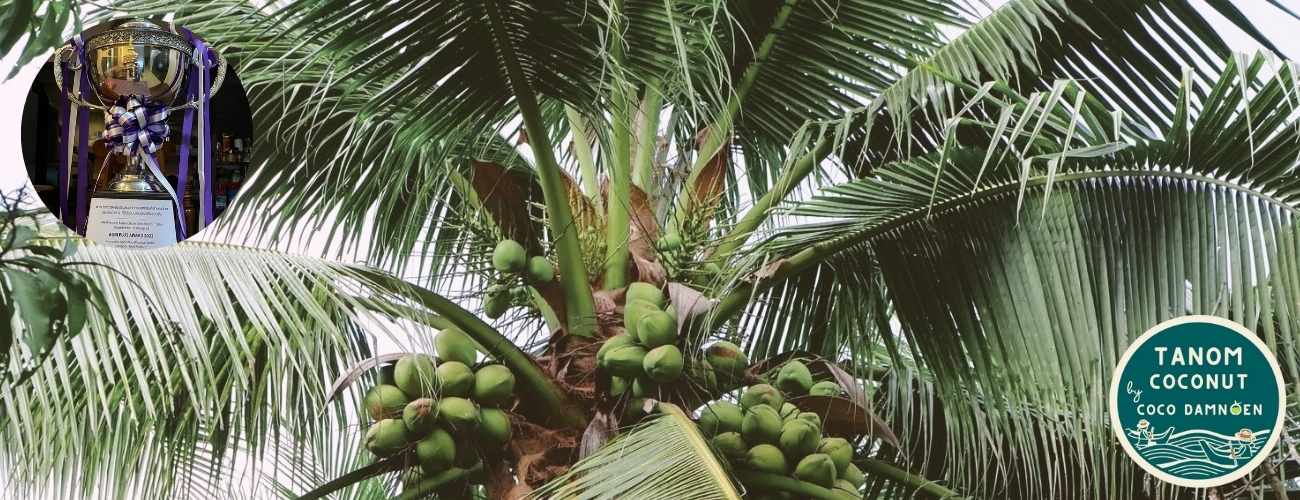Our family owns an organic aromatic coconut farm in Ratchaburi, Thailand. Our young coconuts are exported all over the world. Our aromatic coconut farm was selected to be a model coconut farm for demonstrating and giving knowledge to other farmers. This gives us the chance of building up the Ratchaburi organic coconut farmers network.
The unique soil and growing conditions are what create the unique flavour characteristics of the Ratchaburi Young Aromatic Coconut.
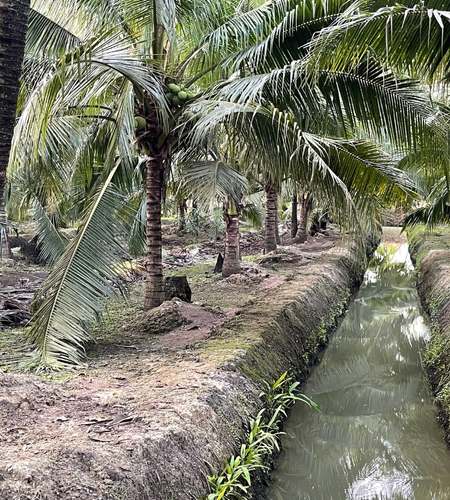
Why Ratchaburi Aromatic Coconut is in the GI List of Thailand
Ratchaburi Aromatic Coconut holds a prestigious spot on Thailand’s Geographical Indication (GI) list due to its unique growing conditions. The soil in Ratchaburi is naturally fertilized loam and muddy loam, enriched by sediment from seawater that accumulated minerals over time. This nutrient-rich soil, found near the estuary, creates an ideal environment for coconut cultivation.
Ratchaburi, located in west-central Thailand, benefits from its geographical position. The plains and lowlands are influenced by seawater intrusion, and the region enjoys a damp climate with frequent rain, high humidity, and an annual rainfall of 1500-2000mm. The average temperature is a consistent 35°C, providing optimal conditions for coconut trees to thrive.
At our farm, we carefully nurture our aromatic coconut trees using organic methods. We harvest the fruits at just the right time—around 20 days after maturity—to ensure the flesh is thick, aromatic, and soft. The coconuts from this region are prized for their delicious flavor and distinctive pandan-like aroma, making them highly sought after.
These geographic and climatic factors contribute to the unique quality of Ratchaburi aromatic coconuts. The water inside the coconuts is packed with healthful antioxidants and natural electrolytes like sodium, potassium, magnesium, and calcium, making it perfect for rehydration. The coconuts are known for their refreshing juice, vibrant green shells, and sweet, tender white flesh.
These unique factors—soil richness, optimal climate, and careful cultivation—make Ratchaburi aromatic coconuts a standout product, recognized on Thailand’s GI list for their exceptional quality.
Regenerative Coconuts Agriculture Project (ReCAP)
We are proud to be part of the Regenerative Coconuts Agriculture Project (ReCAP), a program dedicated to supporting Thai coconut farmers. This project is funded to promote the cultivation of fresh aromatic coconuts through regenerative organic agriculture practices. By participating in ReCAP, we are committed to sustainable farming methods that enrich the soil, improve biodiversity, and ensure long-term environmental health while producing high-quality, flavorful coconuts.
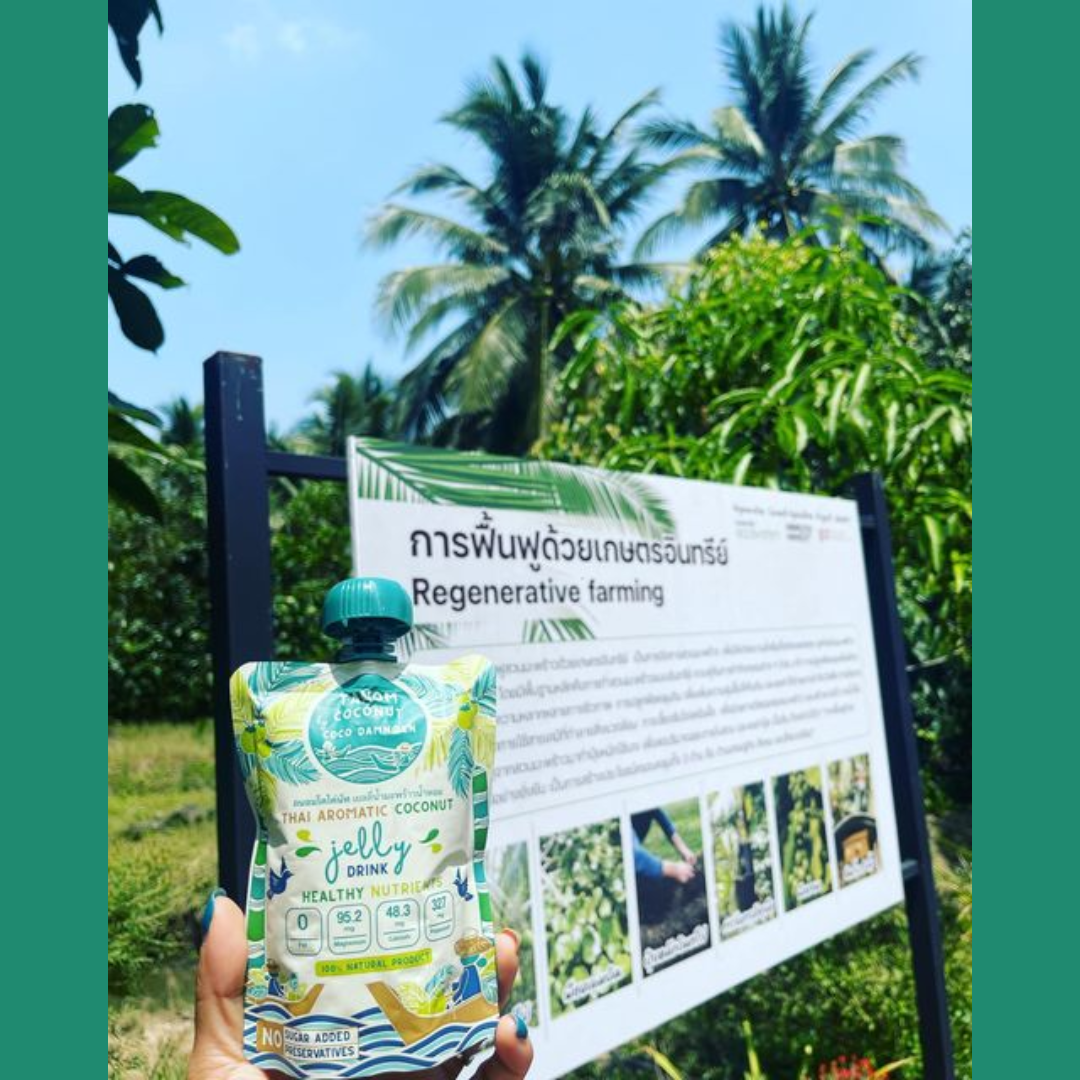
Why Intercropping in Coconut Farm
Our Aromatic Coconut Farm chooses to do intercropping. First of all, being in Damnoen Saduak, Ratchaburi, Thailand, where the soil is rich in nutrients, fruits and vegetables grow very well. Our grandparents love different kinds of fruit and vegetables. Even though our main plants are the aromatic coconut trees, we do have other fruits and vegetables around our coconut trees where there is space and they don’t disturb the growth of our coconut trees.
At our Aromatic Coconut Farm in Damnoen Saduak, Ratchaburi, Thailand, we embrace intercropping to make the most of our nutrient-rich soil. While our primary focus is on growing aromatic coconuts, our farm also produces a variety of fruits and vegetables, just as our grandparents did, who loved cultivating diverse crops.
Our intercropping approach ensures that other plants coexist harmoniously with the coconut trees, without disturbing their growth. Alongside our coconut trees, we grow an array of fruit trees such as coffee, vanilla, mango, mangosteen, banana, star fruit, Maprang, sapodilla, and pineapple. In addition to fruits, we cultivate vegetables like chili, basil, Andrographis paniculata, and pandan. This sustainable farming method enhances biodiversity and maximizes the potential of our organic farm, all while producing high-quality crops.
Why do farmer do intercropping in Coconut farms?
- Extra Income
- Insurance against coconut damage
- Make the most use of Soil
- Good for coconut trees
At our farm, we cultivate a wide variety of fruits and vegetables to support a self-sufficient lifestyle. Our goal is to grow enough to sustain ourselves, but when the harvest is abundant, we love sharing the produce with friends or selling it in the local market. This allows us to stay connected to the community while promoting sustainable farming practices and enjoying the fruits of our labor.
Stingless Bees & Bees’ Homes
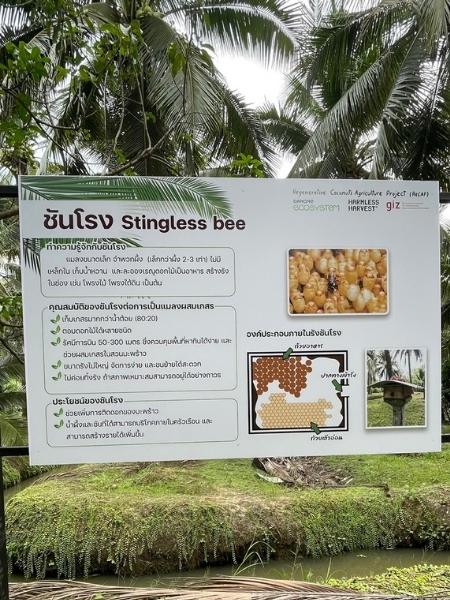
At our farm, we embrace regenerative farming methods, and one approach we’ve adopted is integrating stingless bees and bees alongside our coconut trees. These bees live happily in specially placed homes around the farm, playing a vital role in naturally pollinating the coconut flowers, leading to more abundant coconut fruits.
Did you know that stingless bees can fly over a 300-meter radius? Imagine how many coconut trees they can pollinate within that range! This helps us increase our yield in a natural, sustainable way. Additionally, the honey produced by the bees provides an extra source of income, further supporting our farm’s self-sufficiency.
We believe in maintaining a natural environment for the bees, allowing them to roam freely without disturbance. Their contribution to pollinating our coconuts is invaluable, and they are an essential part of our commitment to organic and sustainable farming.
Safe for the farmers and Looking after the environment.
Coco Damnoen
Weed is one issue in any farming.
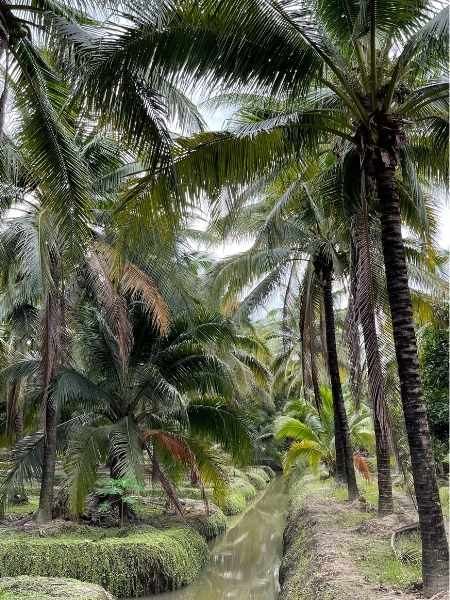
Organic coconut farming means avoiding the use of chemicals in the cultivation process. At our farm, instead of relying on chemicals to control weeds, we plant ground cover crops that help retain moisture in the soil and naturally reduce the need for weeding, making it more sustainable.
We also do not use chemical fertilizers, prioritizing the safety of both the environment and the health of our farmers. Our commitment to organic practices ensures that our coconuts are grown in harmony with nature, promoting a healthier ecosystem for all.
Little canal between row of coconut trees are there for a reason.
– protecting coconut to hit the ground. It’s all about
– transporting coconuts in the farm to the bay for loading to the truck
How do farmer crossing over the canals in the coconut farm?
To minimize investment costs, farmers on our farm use bamboo trunks as bridges for crossing the canals. This traditional method requires skill and balance, as the thin and wobbly bamboo serves as the only path across. Walking along these round bamboo trunks is a testament to the resourcefulness and agility of local farmers, who navigate their farms with precision and care. This practice is not only cost-effective but also environmentally friendly, utilizing natural materials readily available in the area.
Which way would you choose to cross the bamboo bridge in the coconut farm?
- Slowly but steady
- Use another bamboo stick to help balancing
- Use speed to reach the other side quickly
How the coconuts are being picked?
Of course, we do not support monkey labour. Here it is how we pick our coconuts in our coconut farm.
- Canals along every rows of coconut trees are needed for watering and transporting the coconuts
- Sickle is attached to a long stick as tall as the tree. Farmers are working in a team to get the branch of coconuts down to the canal so they can be transporting easily within the farm.
- Coconuts are pushed through canal in the farm to the loading dock of the farm. 4. At loading dock, coconuts are loaded to the trucks and transported to the cleaning center.
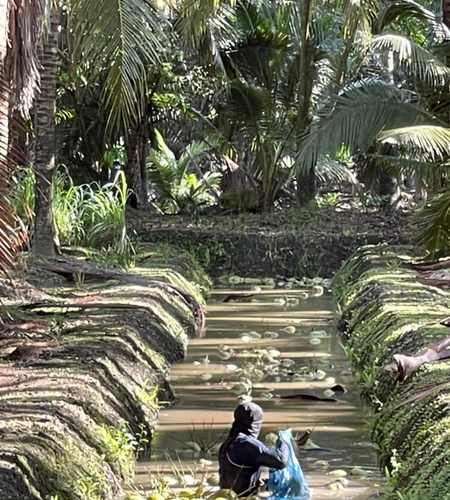
Collecting loose coconuts at our aromatic coconut farm
When coconuts branch is cut from the tree and some coconuts come loose from their branches, transporting them via the canal becomes a manual task. The farmer enters the canal and carefully places the loose coconuts into mesh bags, one by one. Once filled, the bags are securely tied to the coconut branches. These bags are then pulled through the water toward the loading dock, where they can be collected and prepared for transport. This traditional method showcases the ingenuity and hard work of the farmers, using the natural canal system to move coconuts efficiently.
Moreover, the natural floating behavior of coconuts in the canal serves as an effective method for screening their quality. The ideal coconuts, which offer the best taste and fragrant water, will float halfway in the canal, indicating their perfect ripeness.
- Too young coconuts will sink, indicating they might not yet be sweet enough for coconut jelly. However, their soft skin makes them perfect for eating.
- Too old coconuts will float entirely on the surface, signaling that their thicker skin is more suitable for cooking purposes.
This natural screening method helps us select the perfect coconuts for different uses, ensuring that each one is harvested and utilized for its best purpose.

